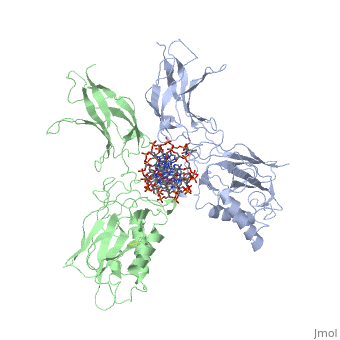NF-kB: Difference between revisions
Jump to navigation
Jump to search
Michal Harel (talk | contribs) No edit summary |
Michal Harel (talk | contribs) No edit summary |
||
| (6 intermediate revisions by 2 users not shown) | |||
| Line 5: | Line 5: | ||
*'''NF-kB1''' (synthesized as '''p105''' and processed to '''p50''')<br /> | *'''NF-kB1''' (synthesized as '''p105''' and processed to '''p50''')<br /> | ||
*'''NF-kB2''' (synthesized as '''p100''' and processed to '''p52''')<br /> | *'''NF-kB2''' (synthesized as '''p100''' and processed to '''p52''')<br /> | ||
*'''RelA''' (or '''p65''')<br /> | *'''RelA''' (or '''p65''' subunit of NF-kB)<br /> | ||
*'''RelB'''<br /> | *'''RelB'''<br /> | ||
*'''cRel'''. | *'''cRel'''. | ||
See also [[NF-kB (hebrew)]]. | |||
== Relevance == | == Relevance == | ||
NF-kB plays a critical role in cancer development and progression and may determine its response to therapy. NF-kB is a target for chemotherapeutic agents<ref>PMID:16673382</ref>. | NF-kB plays a critical role in cancer development and progression and may determine its response to therapy. NF-kB is a target for chemotherapeutic agents<ref>PMID:16673382</ref>. NF-kB is a critical link between inflammation and cancer<ref>PMID:20066113</ref>. | ||
</StructureSection> | </StructureSection> | ||
| Line 31: | Line 33: | ||
**[[1bfs]] – mp50 dimerization domain<br /> | **[[1bfs]] – mp50 dimerization domain<br /> | ||
**[[1u36]], [[1u3j]], [[1u3y]], [[1u3z]], [[1u41]], [[1u42]] – mp50 dimerization domain (mutant)<br /> | **[[1u36]], [[1u3j]], [[1u3y]], [[1u3z]], [[1u41]], [[1u42]] – mp50 dimerization domain (mutant)<br /> | ||
*NF-kB1 (p52) | |||
**[[7cli]], [[7vup]], [[7vuq]], [[7w7l]] – hp52 + DNA <br /> | |||
*NF-kB1 (p105) | *NF-kB1 (p105) | ||
Latest revision as of 10:16, 16 July 2023
FunctionNF-kB or Nuclear Factor NF-kappa is a DNA transcription factor. It is involved in cellular response to stimuli. NF-kB contains a Rel homology domain (RHR) which contains 2 immunoglobulin-like subdomains which interact with the major groove of DNA[1]. I-κ-B-α is an inhibitor of NF-kB. There are 5 proteins in the NF-kB family:
See also NF-kB (hebrew). RelevanceNF-kB plays a critical role in cancer development and progression and may determine its response to therapy. NF-kB is a target for chemotherapeutic agents[2]. NF-kB is a critical link between inflammation and cancer[3]. |
| ||||||||||
3D structures of NF-kappaB3D structures of NF-kappaB
Updated on 16-July-2023
ReferencesReferences
- ↑ Hayden MS, Ghosh S. Signaling to NF-kappaB. Genes Dev. 2004 Sep 15;18(18):2195-224. PMID:15371334 doi:http://dx.doi.org/10.1101/gad.1228704
- ↑ Karin M. NF-kappaB and cancer: mechanisms and targets. Mol Carcinog. 2006 Jun;45(6):355-61. PMID:16673382 doi:http://dx.doi.org/10.1002/mc.20217
- ↑ Karin M. NF-kappaB as a critical link between inflammation and cancer. Cold Spring Harb Perspect Biol. 2009 Nov;1(5):a000141. doi:, 10.1101/cshperspect.a000141. PMID:20066113 doi:http://dx.doi.org/10.1101/cshperspect.a000141
